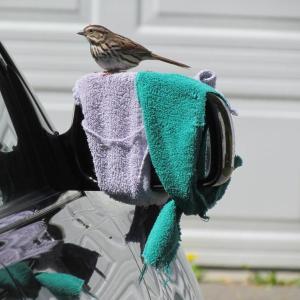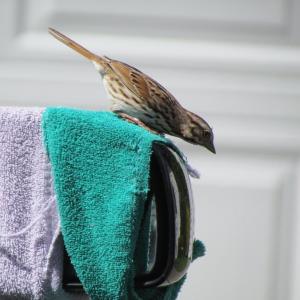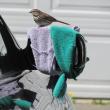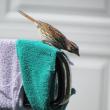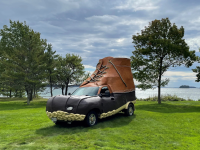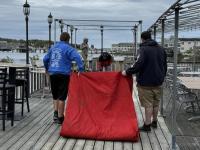Song Sparrow Attacks Its Reflection
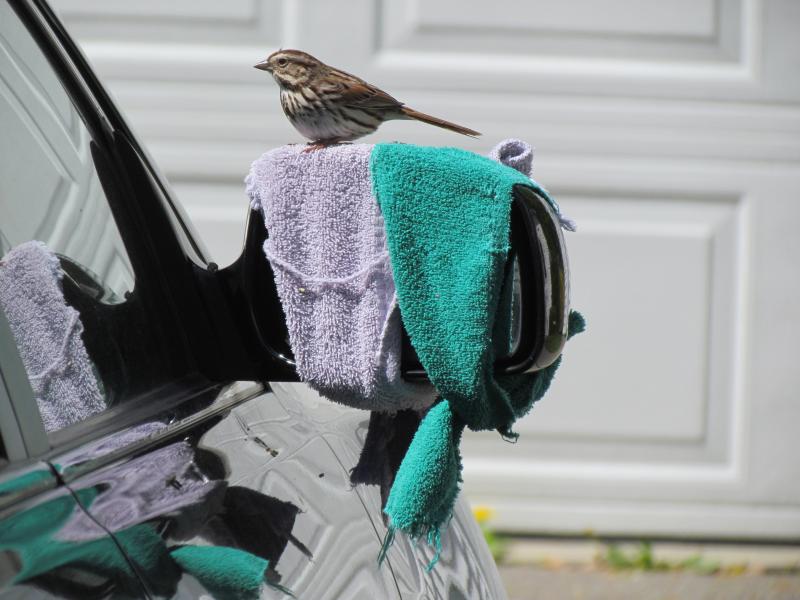 A song sparrow in the authors’ yard has taken to attacking its own reflection. Attempts to thwart the self-attack have been in vain. Courtesy of Jeff Wells
A song sparrow in the authors’ yard has taken to attacking its own reflection. Attempts to thwart the self-attack have been in vain. Courtesy of Jeff Wells
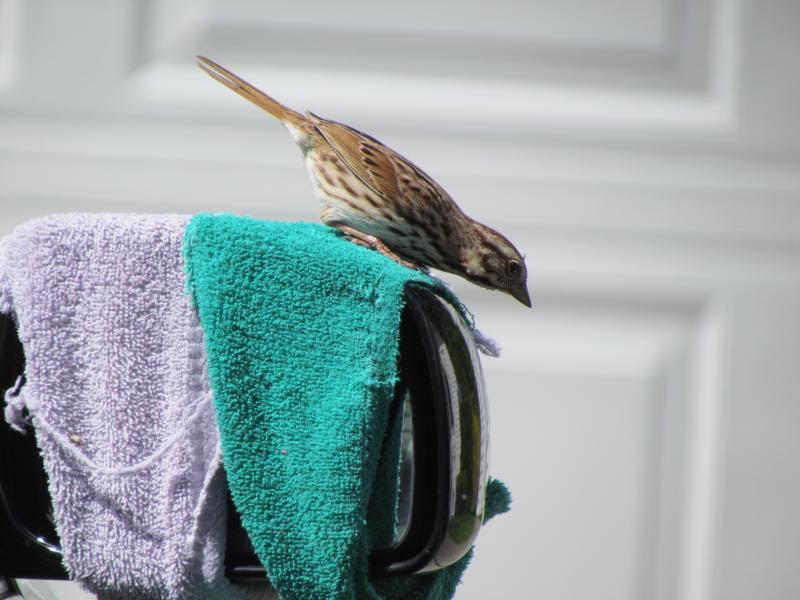 Despite the commonly held belief that reflection-fighting was a male bird thing, the authors saw evidence suggesting this individual could be a female. Courtesy of Jeff Wells
Despite the commonly held belief that reflection-fighting was a male bird thing, the authors saw evidence suggesting this individual could be a female. Courtesy of Jeff Wells
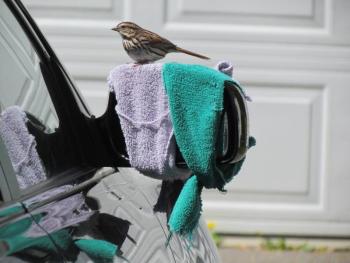 A song sparrow in the authors’ yard has taken to attacking its own reflection. Attempts to thwart the self-attack have been in vain. Courtesy of Jeff Wells
A song sparrow in the authors’ yard has taken to attacking its own reflection. Attempts to thwart the self-attack have been in vain. Courtesy of Jeff Wells
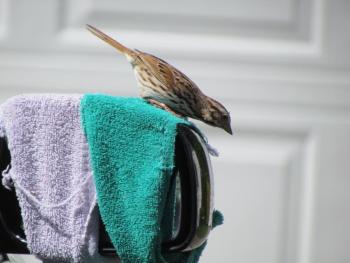 Despite the commonly held belief that reflection-fighting was a male bird thing, the authors saw evidence suggesting this individual could be a female. Courtesy of Jeff Wells
Despite the commonly held belief that reflection-fighting was a male bird thing, the authors saw evidence suggesting this individual could be a female. Courtesy of Jeff Wells
For years we have read about and had acquaintances tell us stories about birds that would attack their reflections in windows, shiny hubcaps, and car mirrors. We had never experienced it ourselves.
Until now.
It started when the next-door neighbor came over to show us a video of a bird acting strangely. The video showed a song sparrow flying repeatedly at and pecking at its reflection in the side mirror of their car. The next morning, as we looked out the kitchen window, we noticed the bird doing it again after the neighbors had left for work. We placed some towels over their mirrors and that seemed to alleviate the problem for the time being.
But later in the day we heard an agitated song sparrow chipping from our own driveway. Although we have had a pair breeding in our yard for many years, this sound was not one we had heard here. Sure enough, the bird was now doing the same on the mirrors of one of our cars. We dutifully placed towels, held in place with rubber bands, over the mirrors on that car.
But it wasn’t enough. The bird moved on to attacking the mirrors on our son’s car. We covered those as well.
The phenomena of birds attacking their reflections is now well-known in the modern era in which having lots of windows, mirrors, and other reflective surfaces in human-made structures and contraptions is highly desirable. Birds have been observed exhibiting this behavior all over the world. Here in the U.S., some of the species most commonly seen attacking reflections are American robins, northern cardinals, chipping sparrows, and song sparrows—all species that are found regularly amidst the suburban setting where windows and mirrors are commonplace. We once saw a common grackle working itself over pretty hard in a store window in a small town in Maryland.
Most often it is thought that the attacking birds are males, hopped up on breeding season hormones, aggressively trying to drive off what they perceive as another male intruding on their territory. We had assumed that to be the case with our song sparrow. We had already observed that there were two male song sparrows singing back and forth across an apparent territorial line that seemed to split our property into two song sparrow territories.
And it may be that one of the birds doing the attacking is indeed a male. However, we observed a very curious thing about this particular attacking bird. While the bird was attacking its reflection, a male song sparrow was singing right above its head in our flowering crabapple. The attacking bird was persistent. Even with towels covering our mirrors it still tried to attack, sometimes finding its reflection on various windows of the car depending on the lighting during the day. And often when it was fighting itself, the male song sparrow was singing from right overhead, ignored by the attacking bird.
This made us wonder if female birds might ever engage in this behavior. We did a quick internet search and discovered two papers, one published in 1938 and another in 1947, that described female cardinals attacking their reflections in windows. In the 1947 paper (which was incidentally published by noted ornithologist George Miksch Sutton from observations he made on his walk to his office at Cornell University), the author notes that famed ornithologist Margaret Morse Nice, who intensively studied song sparrows, had found that females would sometimes attack other female song sparrows during periods of territoriality.
We don’t know if our attacking song sparrow is a male or a female as the sexes look alike. But we wonder if that may be the case given that the bird never attacks the nearby singing male, and we have never directly seen the attacking bird sing, only vigorously call.
In any case, it is yet another fascinating and engaging mystery of the bird world!
Jeffrey V. Wells, Ph.D., is a Fellow of the Cornell Lab of Ornithology and Vice President of Boreal Conservation for National Audubon. Dr. Wells is one of the nation's leading bird experts and conservation biologists and author of “Birder’s Conservation Handbook”. His grandfather, the late John Chase, was a columnist for the Boothbay Register for many years. Allison Childs Wells, formerly of the Cornell Lab of Ornithology, is a senior director at the Natural Resources Council of Maine, a nonprofit membership organization working statewide to protect the nature of Maine. Both are widely published natural history writers and are the authors of the books, “Maine’s Favorite Birds” and “Birds of Aruba, Bonaire, and Curaçao: A Site and Field Guide” from Cornell Press.
Event Date
Address
United States

